Integration of ERT, IP and SP Methods in Hard Rock Engineering
Abstract
:1. Introduction
2. Study Area and Hydrogeology
3. Materials and Methods
4. Results and Discussion
4.1. Delineation of Subsurface Layers
4.2. Detection of Faults
4.3. Water-Clay Distinction
4.4. Groundwater Flow Modeling
5. Conclusions
Author Contributions
Funding
Institutional Review Board Statement
Informed Consent Statement
Data Availability Statement
Acknowledgments
Conflicts of Interest
References
- Fan, X.M.; Xu, Q.; Zhang, Z.Y.; Meng, D.S.; Tang, R. The genetic mechanism of a translational landslide. Bull. Eng. Geol. Environ. 2009, 68, 231–244. [Google Scholar] [CrossRef]
- Li, K.; Shang, Y.; He, W.; Lin, D.; Hasan, M.; Wang, K. An engineering site suitability index (ESSI) for the evaluation of geological situations based on a multi-factor interaction matrix. Bull. Eng. Geol. Environ. 2017, 78, 569–577. [Google Scholar] [CrossRef]
- Hasan, M.; Shang, Y.; Jin, W.; Akhter, G. An engineering site investigation using non-invasive geophysical approach. Environ. Earth Sci. 2020, 79, 265. [Google Scholar] [CrossRef]
- Asch, T.W.J.V.; Hendriks, M.R.; Hessel, R.; Rappange, F.E. Hydrological triggering conditions of landslides in varved clays in the French Alps. Eng. Geol. 1996, 42, 239–251. [Google Scholar] [CrossRef]
- Hongbin, L.V.; Chengpeng, L.; Bill, X.H.; Jiaxin, R.; Yanan, Z.; Qiang, X.; Juxiu, T. Characterizing groundwater flow in a translational rock landslide of southwestern China. Bull. Eng. Geol. Environ. 2017, 78, 3223–3237. [Google Scholar] [CrossRef]
- Ayodele, Y.G.; Joshua, A.O.; Sunday, O.J. An Engineering Site Characterization using Geophysical Methods: A Case Study from Akure, Southwestern Nigeria. J. Earth Sci. Geotech. Eng. 2015, 5, 57–77. [Google Scholar]
- Wyns, R.; Baltassat, J.M.; Lachassagne, P.; Legchenko, A.; Vairon, J.; Mathieu, F. Application of Magnetic Resonance Soundings to Groundwater Reserves Mapping in Weathered Basement Rocks (Brittany, France). Bull. Soc. Géol. Fr. 2002, 175, 21–34. [Google Scholar] [CrossRef]
- Taylor, R.; Howard, K. A tectono-geomorphic model of the hydrogeology of deeply weathered crystalline rock: Evidence from Uganda. Hydrogeol. J. 2000, 8, 279–294. [Google Scholar] [CrossRef]
- Gao, Q.; Shang, Y.; Hasan, M.; Jin, W.; Yang, P. Evaluation of a Weathered Rock Aquifer Using ERT Method in South Guangdong, China. Water 2018, 10, 293. [Google Scholar] [CrossRef] [Green Version]
- Hasan, M.; Shang, Y.; Jin, W. Delineation of weathered/fracture zones for aquifer potential using an integrated geophysical approach: A case study from South China. J. Appl. Geophys. 2018, 157, 47–60. [Google Scholar] [CrossRef]
- Guoxing, C.; Jiao, Z.; Mengyun, O.; Wenping, G. Three- dimensional site characterization with borehole data-A case study of Suzhou area. Eng. Geol. 2018, 234, 65–82. [Google Scholar]
- Shang, Y.J.; Yang, C.G.; Jin, W.J.; Chen, Y.W.; Hasan, M.; Wang, Y.; Li, K.; Lin, D.M.; Zhou, M. Application of Integrated Geophysical Methods for Site Suitability of Research Infrastructures (RIs) in China. Appl. Sci. 2021, 11, 8666. [Google Scholar] [CrossRef]
- Sikandar, P.; Christen, E.W. Geoelectrical sounding for the estimation of hydraulic conductivity of alluvial aquifers. Water Resour. Manag. 2012, 26, 1201–1215. [Google Scholar] [CrossRef]
- Chang, L.C.; Ho, C.C.; Yeh, M.S.; Yang, C.C. An integration approach for conjunctive-use planning of surface and subsurface water system. Water Resour. Manag. 2011, 25, 29–78. [Google Scholar] [CrossRef]
- Bianchi, G.; Fasani Bozzano, F.; Cardarelli, E.; Cercato, M. Underground cavity investigation within the city of Rome (Italy): A multi-disciplinary approach combining geological and geophysical data. Eng. Geol. 2013, 152, 109–121. [Google Scholar] [CrossRef]
- Suzuki, K.; Toda, S.; Kusunoki, K.; Fujimitsu, Y.; Mogi, T.; Jomori, A. Case studies of electrical and electromagnetic methods applied to mapping active faults beneath the thick quaternary. Eng. Geol. 2000, 56, 29–45. [Google Scholar] [CrossRef]
- Kneisel, C. Assessment of subsurface lithology in mountain environments using 2D resistivity imaging. Geomorphology 2006, 80, 32–44. [Google Scholar] [CrossRef]
- Cardarelli, E.; Cercato, M.; Di Filippo, G. Assessing foundation stability and soil structure interaction through integrated geophysical techniques: A case history in Rome (Italy). Near Surf. Geophys. 2007, 59, 244–259. [Google Scholar] [CrossRef]
- Chambers, J.C.; Kuras, O.; Meldrum, P.I.; Ogilvy, R.D.; Hollands, J. Electrical resistivity tomography applied to geologic, hydrologic and engineering investigations at a former waste disposal site. Geophysics 2006, 71, B231–B239. [Google Scholar] [CrossRef] [Green Version]
- Martinez, J.; Mendoza, R.; Rey, J.; Sandoval, S.; Hidalgo, M.C. Characterization of Tailings Dams by Electrical Geophysical Methods (ERT, IP): Federico Mine (La Carolina, Southeastern Spain). Minerals 2021, 11, 145. [Google Scholar] [CrossRef]
- Kim, J.H.; Yi, M.J.; Song, Y.; Seol, S.J.; Kim, K.S. Application of geophysical methods to the safety analysis of an earth dam. J. Environ. Eng. Geophys. 2007, 12, 221–235. [Google Scholar] [CrossRef]
- Osinowo, O.O.; Akanji, A.O.; Akinmosin, A. Integrated geophysical and geotechnical investigation of the failed portion of a road in Basement Complex terrain, southwestern Nigeria. RMZ—Mater. Geoenviron. 2011, 58, 143–162. [Google Scholar]
- Lghoul, M.; Teixido, T.; Pena, J.A.; Hakkou, R.; Kchikach, A.; Guerin, R.; Jaffal, M.; Zouhri, L. Electrical and Seismic Tomography Used to Image the Structure of a Tailings Pond at the Abandoned Kettara Mine, Morocco. Int. J. Mine Water 2012, 31, 53–61. [Google Scholar]
- Loperte, A.; Soldovieri, F.; Palombo, A.; Santini, F.; Llapenna, V. An integrated geophysical approach for water infiltration detection and characterization at Monte Cotugno rock-fill Dam (southern Italy). Eng. Geol. 2016, 211, 162–170. [Google Scholar] [CrossRef]
- Samyn, K.; Mathieu, F.; Bitri, A.; Nachbaur, A.; Closset, L. Integrated geophysical approach in assessing karst presence and sinkhole susceptibility along flood-protection dykes of the Loire River, Orléans, France. Eng. Geol. 2014, 183, 170–184. [Google Scholar] [CrossRef] [Green Version]
- Lin, C.H.; Lin, C.P.; Hung, Y.C.; Chung, C.C.; Wu, P.L.; Liu, H.C. Application of geophysical methods in a dam project: Life cycle perspective and Taiwan experience. J. Appl. Geophys. 2018, 158, 82–92. [Google Scholar] [CrossRef]
- Kukemilks, K.; Wagner, J.F. Detection of Preferential Water Flow by Electrical Resistivity Tomography and Self-Potential Method. Appl. Sci. 2021, 11, 4224. [Google Scholar] [CrossRef]
- Hung, Y.C.; Chou, H.S.; Lin, C.P. Appraisal of the Spatial Resolution of 2D Electrical Resistivity Tomography for Geotechnical Investigation. Appl. Sci. 2020, 10, 4394. [Google Scholar] [CrossRef]
- Hasan, M.; Shang, Y.; Jin, W.; Akhter, G. Investigation of fractured rock aquifer in South China using electrical resistivity tomography and self-potential methods. J. Mt. Sci. 2019, 16, 850–869. [Google Scholar] [CrossRef]
- Revil, A.; Murugesu, M.; Prasad, M.; Le Breton, M. Alteration of volcanic rocks: A new non-intrusive indicator based on induced polarization measurements. J. Volcanol. Geotherm. Res. 2017, 341, 351–362. [Google Scholar] [CrossRef]
- Johnson, T.C.; Versteeg, R.J.; Ward, A.F.; Day-Lewis, D.; Revil, A. Improved hydrogeophysical characterization and monitoring through high performance electrical geophysical modeling and inversion. Geophysics 2010, 75, WA27–WA41. [Google Scholar] [CrossRef]
- Jardani, A.; Revil, A.; Barrash, W.; Crespy, A.; Rizzo, E.; Straface, S.; Cardiff, M.; Malama, B.; Miller, C.; Johnson, T. Reconstruction of the water table from self potential data: A Bayesian approach. Groundwater 2009, 47, 213–227. [Google Scholar] [CrossRef]
- Bureau of Geology and Mineral Resources of Guangdong Province. Regional Geology of Guangdong Province; Geology Publishing House: Beijing, China, 1988; pp. 1–602. (In Chinese)
- Tejero, A.; Chávez, R.E.; Urbierta, J.; Flores-Márquez, E.L. Cavity detection in the southwestern hilly portion of Mexico City by resistivity imaging. J. Environ. Eng. Geophys. 2002, 7, 130–139. [Google Scholar] [CrossRef]
- Lech, M.; Skutnik, Z.; Bajda, M.; Markowska-Lech, K. Applications of Electrical Resistivity Surveys in Solving Selected Geotechnical and Environmental Problems. Appl. Sci. 2020, 10, 2263. [Google Scholar] [CrossRef] [Green Version]
- Loke, M.H.; Acworth, I.; Dahlin, T. A comparison of smooth and blocky inversion methods in 2D electrical imaging surveys. Explor. Geophys. 2003, 34, 182–187. [Google Scholar] [CrossRef]
- Loke, M.H.; Barker, R.D. Rapid least-squares inversion of apparent resistivity pseudosections by a quasi-Newton method. Geophys. Prospect. 1996, 44, 131–152. [Google Scholar] [CrossRef]
- Loke, M.H.; Chambers, J.E.; Rucker, D.F.; Kuras, O.; Wilkinson, P.B. Recent developments in the direct-current geoelectrical imaging method. J. Appl. Geophys. 2013, 95, 135–156. [Google Scholar] [CrossRef]
- Ward, S.H. Resistivity and Induced Polarization Methods in Geotechnical and Environmental Geophysics; Society of Exploration Geophysicists: Tulsa, OK, USA, 1990; pp. 147–190. [Google Scholar]
- Routh, P.S.; Oldenburg, D.W. Electromagnetic coupling in frequency-domain induced polarization: A method for removal. Geophys. J. Int. 2001, 145, 59–76. [Google Scholar] [CrossRef]
- Dahlin, T.; Leroux, V.; Nissen, J. Measuring Techniques in Induced Polarization Imaging. J. Appl. Geophys. 2002, 50, 279–298. [Google Scholar] [CrossRef] [Green Version]
- Yuval; Oldenburg, D.W. Computation of Cole-Cole parameters from IP data. Geophysics 1997, 62, 436–448. [Google Scholar] [CrossRef] [Green Version]
- Telford, W.M.; Geldarl, L.P.; Sheriff, R.E. Applied Geophysics; Cambridge University Press: Cambridge, UK, 1990. [Google Scholar]
- Meisner, P. A method of qualitative interpretation of self potential measurements. Geophys. Prospect. 1962, 10, 203–218. [Google Scholar] [CrossRef]
- Paul, M.K. Direct interpretation of self-potential anomalies caused by inclined sheets of finite horizontal extension. Geophysics 1965, 30, 418–423. [Google Scholar] [CrossRef]
- Lowrie, W. Fundamentals of Geophysics; Cambridge University Press: Cambridge, UK, 1997. [Google Scholar]
- Self Potential Technique. 2008. Available online: http://www.nga.com/Geo_ser_Self_potential_tech.htm (accessed on 20 July 2008).
- Mitchell, J.K. Fundamentals of Soil Behavior; John Wiley and Sons: New York, NY, USA, 1976. [Google Scholar]
- Corwin, R.F.; Hoover, D.B. The self potential method in geothermal exploration. Geophysics 1979, 44, 226. [Google Scholar] [CrossRef] [Green Version]
- Griffiths, D.H.; Barker, R.D. Two-dimensional resistivity imaging and modeling in areas of complex geology. J. Appl. Geophys. 1993, 29, 211–226. [Google Scholar] [CrossRef]
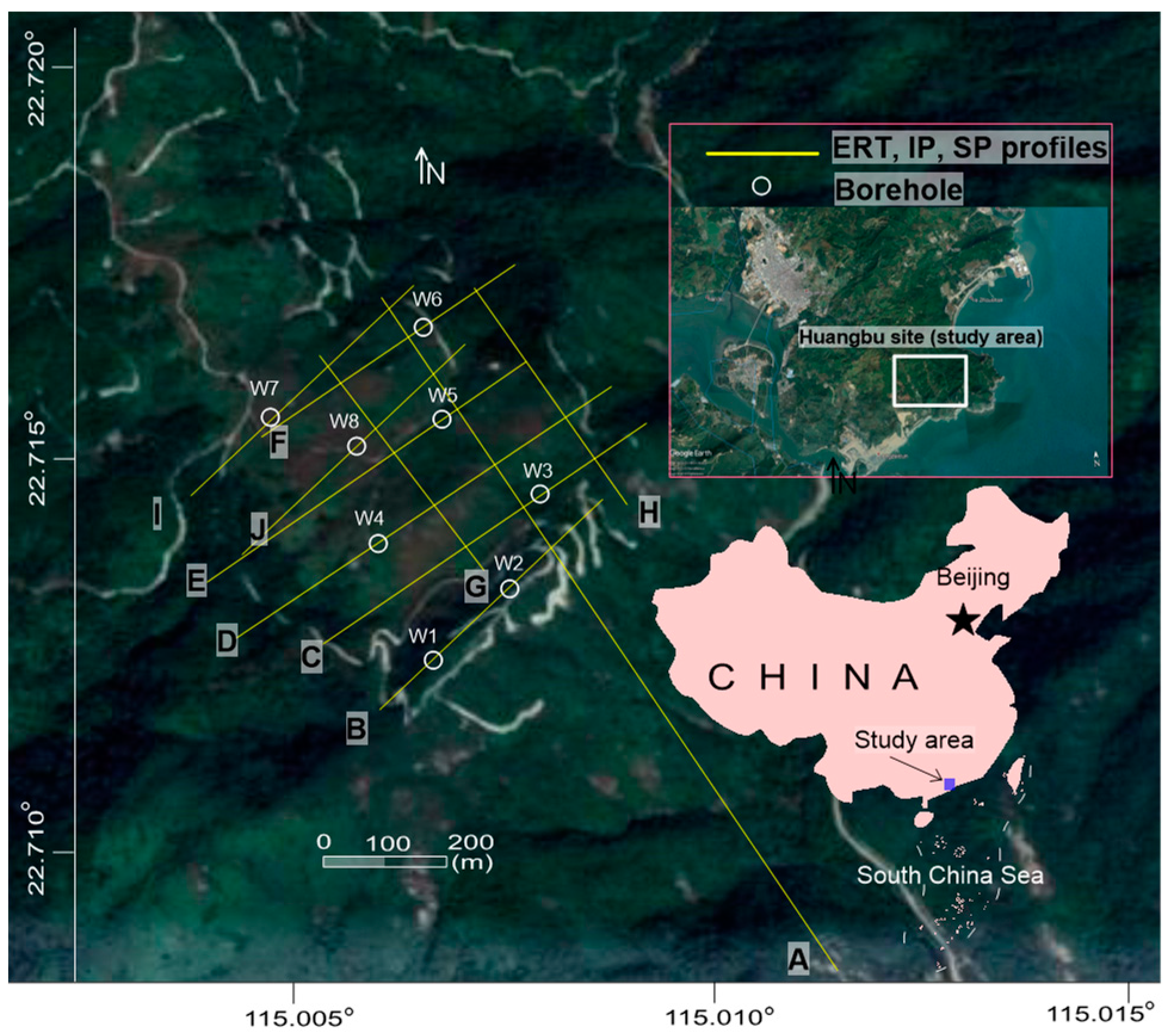
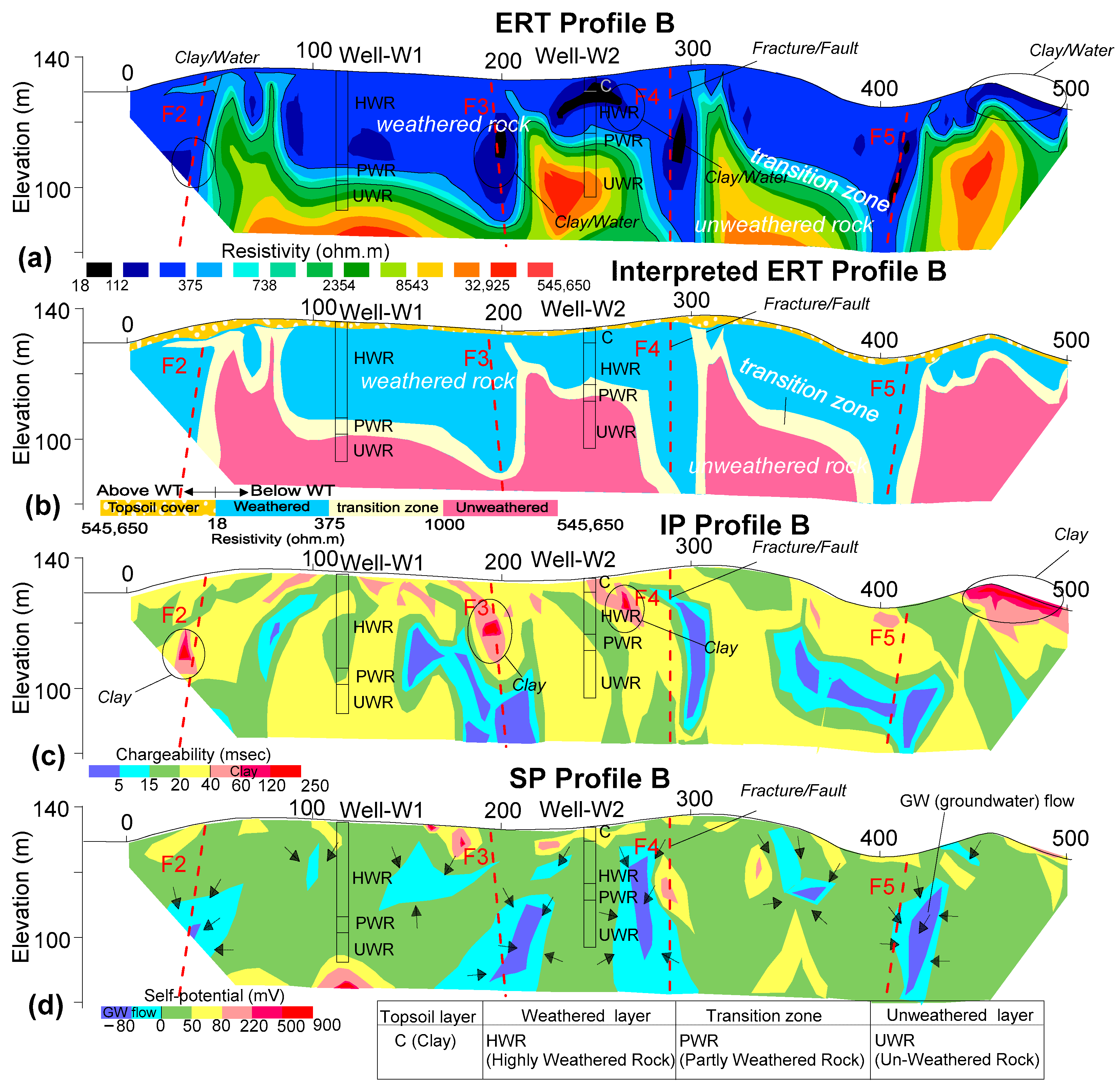
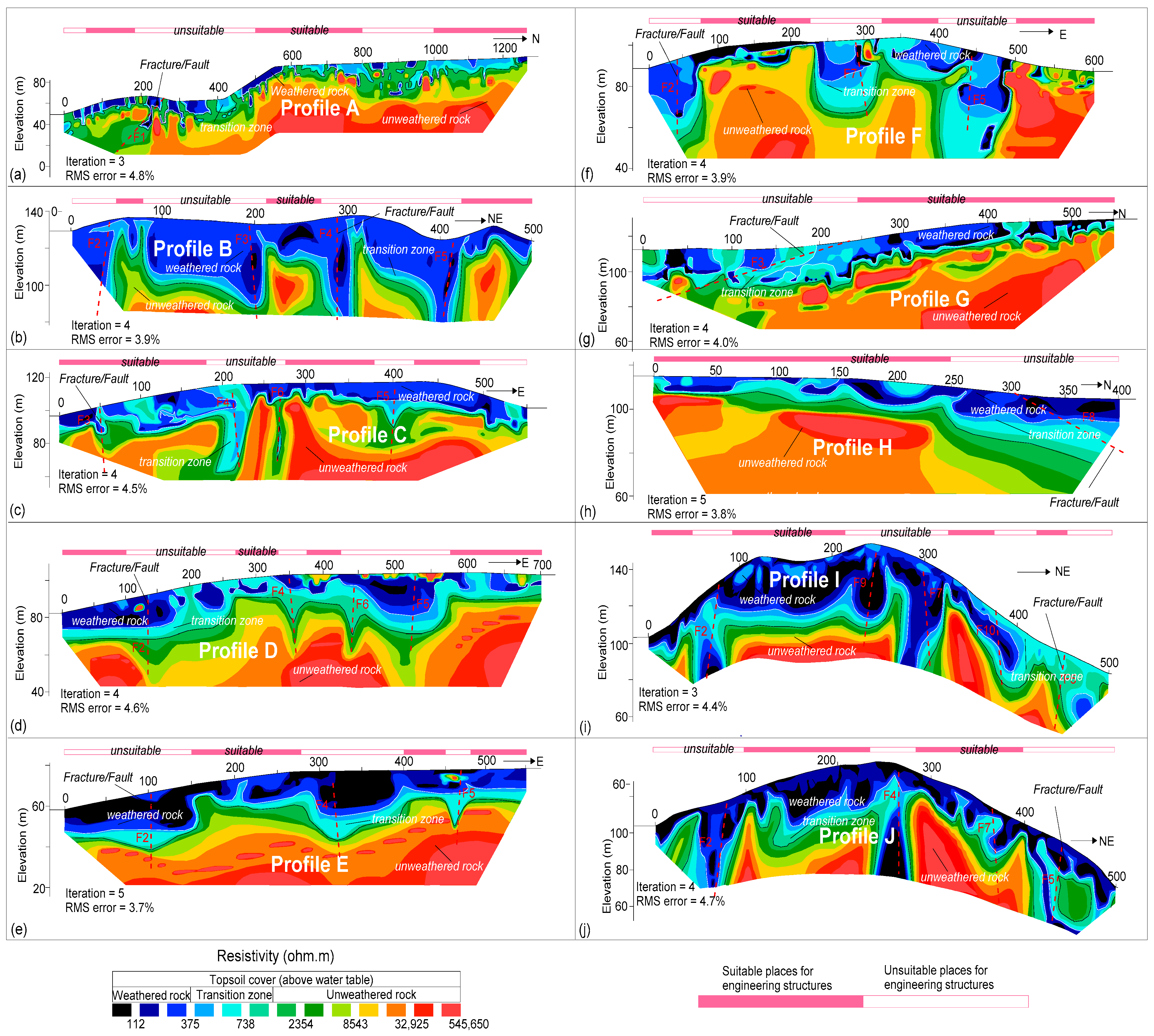
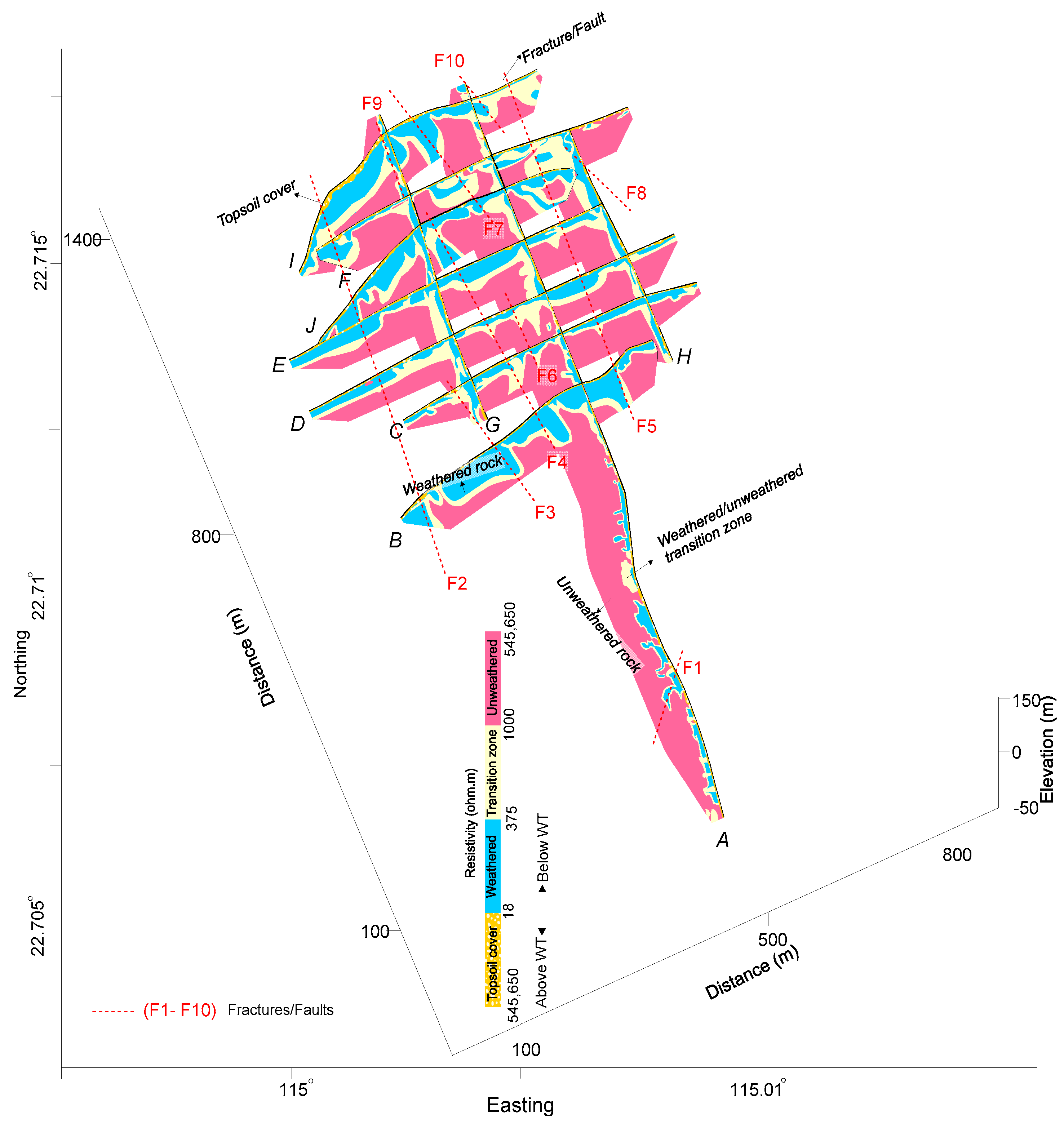
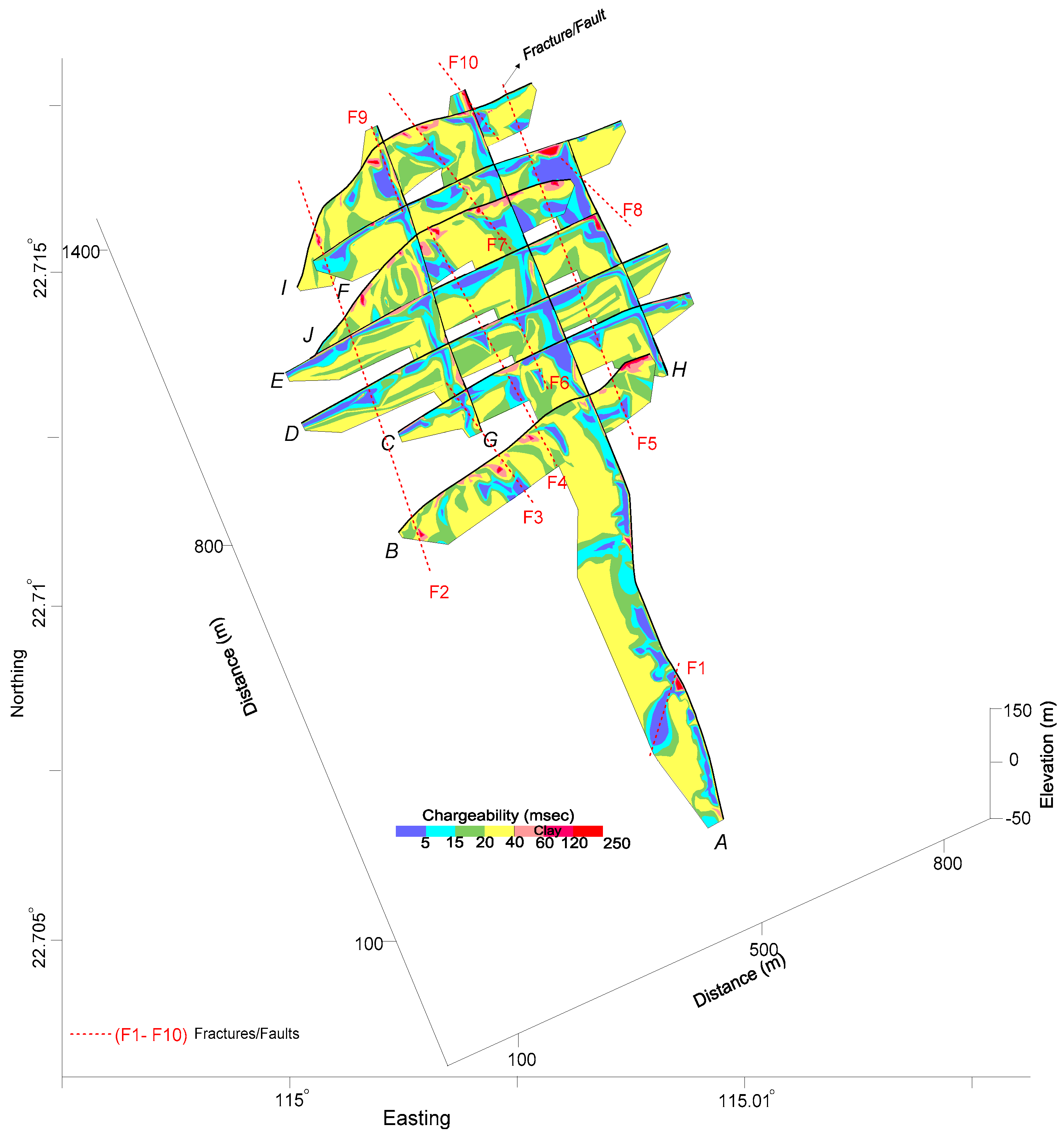
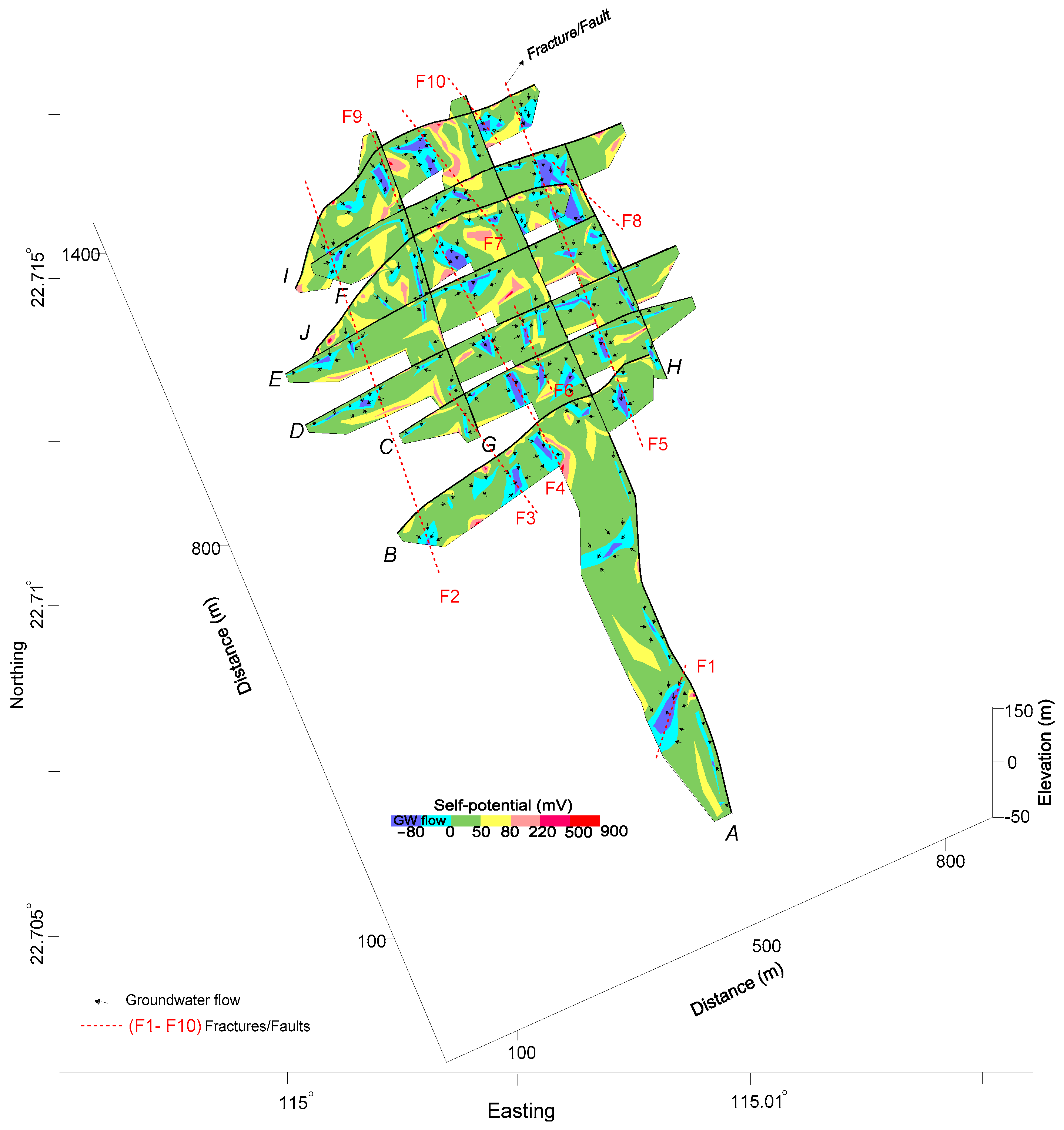
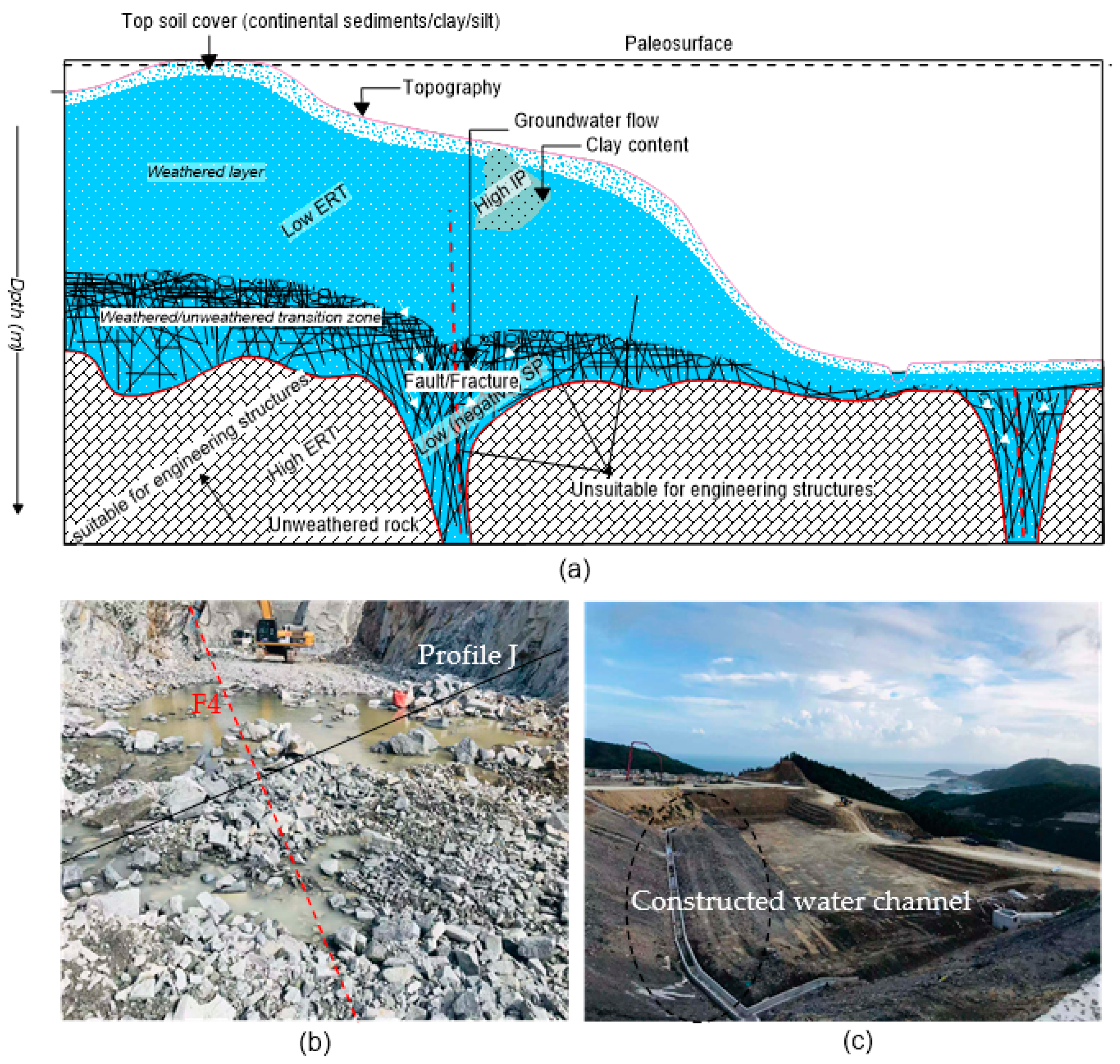
| Profile | Electrodes | Profile Length (m) | Electrode Spacing (m) | 1st Layer Depth (m) | Last Layer Dept (m) | Layers | Measurements |
|---|---|---|---|---|---|---|---|
| A | 261 | 1300 | 5 | 7.5 | 127.5 | 25 | 6525 |
| B | 101 | 500 | 5 | 7.5 | 127.5 | 25 | 2525 |
| C | 111 | 550 | 5 | 7.5 | 127.5 | 25 | 2775 |
| D | 141 | 700 | 5 | 7.5 | 127.5 | 25 | 3525 |
| E | 111 | 550 | 5 | 7.5 | 127.5 | 25 | 2775 |
| F | 121 | 600 | 5 | 7.5 | 127.5 | 25 | 3025 |
| G | 111 | 550 | 5 | 7.5 | 127.5 | 25 | 2775 |
| H | 81 | 400 | 5 | 7.5 | 127.5 | 25 | 2025 |
| I | 101 | 500 | 5 | 7.5 | 127.5 | 25 | 2525 |
| J | 101 | 500 | 5 | 7.5 | 127.5 | 25 | 2525 |
| Profile | Average Depth/Thickness of Subsurface Layers | Most Suitable Places for Engineering Structures (m) | |||
|---|---|---|---|---|---|
| Topsoil Thickness (m) | Weathered Layer Thickness (m) | Transition Zone Thickness (m) | Unweathered Layer Depth (m) | ||
| A | 3 | 10 | 7 | 20 | 60–180, 500–800, 1000–1300 |
| B | 3 | 26 | 6 | 35 | 50–75, 220–275, 430–500 |
| C | 3 | 10 | 7 | 20 | 0–175, 275–375, 425–490 |
| D | 3 | 10 | 9 | 22 | 0–100, 275–325, 375–425, 575–700 |
| E | 2 | 11 | 7 | 20 | 150–275, 400–450, 480–550 |
| F | 3 | 16 | 13 | 32 | 75–225, 325–400, 500–600 |
| G | 3 | 11 | 6 | 20 | 240–550 |
| H | 2 | 8 | 8 | 18 | 0–250 |
| I | 5 | 15 | 10 | 30 | 0–50, 90–210, 325–375, 430–450 |
| J | 3 | 16 | 11 | 30 | 100–225, 290–400 |
Publisher’s Note: MDPI stays neutral with regard to jurisdictional claims in published maps and institutional affiliations. |
© 2021 by the authors. Licensee MDPI, Basel, Switzerland. This article is an open access article distributed under the terms and conditions of the Creative Commons Attribution (CC BY) license (https://creativecommons.org/licenses/by/4.0/).
Share and Cite
Shao, P.; Shang, Y.; Hasan, M.; Yi, X.; Meng, H. Integration of ERT, IP and SP Methods in Hard Rock Engineering. Appl. Sci. 2021, 11, 10752. https://doi.org/10.3390/app112210752
Shao P, Shang Y, Hasan M, Yi X, Meng H. Integration of ERT, IP and SP Methods in Hard Rock Engineering. Applied Sciences. 2021; 11(22):10752. https://doi.org/10.3390/app112210752
Chicago/Turabian StyleShao, Peng, Yanjun Shang, Muhammad Hasan, Xuetao Yi, and He Meng. 2021. "Integration of ERT, IP and SP Methods in Hard Rock Engineering" Applied Sciences 11, no. 22: 10752. https://doi.org/10.3390/app112210752
APA StyleShao, P., Shang, Y., Hasan, M., Yi, X., & Meng, H. (2021). Integration of ERT, IP and SP Methods in Hard Rock Engineering. Applied Sciences, 11(22), 10752. https://doi.org/10.3390/app112210752







